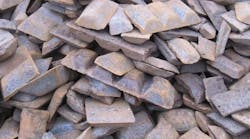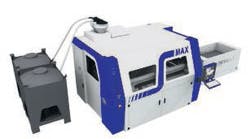The technological advances in prototyping continue to accelerate, and depending on a metalcaster’s needs or plans there is something to enhance their operation. ExOne Corp.’s Pro- Metal RCT division designs production-scale machines for printing three-dimensional shapes. Because its printing-medium is foundry resin, the “prototypes” are used as molds and cores for sand casting — printed from CAD data.
The newest model from ProMetal is the S-Max for foundries and design shops, which is able to produce molds and cores for finished castings within hours of receiving the finished design data. Notably, the system can deliver complete mold and core designs, including complex internal details that cannot be produced by typical sand molding techniques.
The S-Max system also works with proven casting materials (quartz and specialty sands) and has an integrated, on-demand system for sand supply and management. This means support systems are not required.
The printing technique is precision-calibrated to measure the binding agent properly. Finished parts have less than 2% binder content. The S-Max is able to produce parts measuring 70.8 X 39.4 X 27.5 in. Importantly, for many foundries, the S-Max has a small footprint 275.5 X 141 X112.6 in.
For foundries or diecasters seeking to produce prototypes or finished parts in metal, laser-sintering system developer EOS Electro Optical Systems GmbH last fall introduced a new machine for metal-additive manufacturing, for demanding applications such as production of tooling and medical products.
The new EOSINT M 280 system is available either with the same 200-Watt fiber-laser that EOS pioneered with the EOSINT M 270, or a 400-Watt fiber-laser option. The higher-power laser can melt more metal powder per second, thus achieving shorter build times and higher system productivity. The system will significantly reduce costs-per-part in manufacturing applications, according to EOS, thereby increasing the competitiveness of laser sintering compared to other technologies and opening up viable new viable applications.
Another improvement of the EOSINT M 280 is the increase of the maximum building height up to 325 mm. This enables taller parts to be placed in the process chamber, expanding the range of product applications, including hybrid part building for prototype tooling (i.e., producing complex parts by building additional material on top of a prefabricated part.)
EOS reports that it carried out extensive process investigations, including fluid dynamics simulations, to optimize the EOSINT M 280 gas-management system. “A high-velocity laminar flow of protective gas across the entire build area, combined with the high-capacity recirculating filter system, ensures even more uniform process conditions. As a result, stable melting behavior is ensured even over long periods of time and with higher laser power. This results in further improved reproducibility of the part properties,” according to a release.
The gas-management system makes EOSINT M 280 an effective system for further material and process developments. It supports processes under nitrogen gas atmosphere (created by compressed air via an integrated nitrogen generator) as well as under argon gas. Further improvements in the gas-management system allow reductions in gas consumption and prolonged filter life, which heightens the system’s cost-effectiveness and user-friendliness.
The EOSINT M 280 builds on the Part Property Management concept, which enables standardization and comparability of building processes, based on the so-called Part Property Profiles (PPP). “By ensuring a consistent quality assurance along the entire process chain, EOS enables machine users to reliably produce parts based on defined material and part properties,” the developer states.
Operators will be able to use all the same metal materials available to them in previous EOSINT models, using the same or with optimized parameter sets. Currently, EOS offers 10 series materials, including a new nickel alloy, EOS NickelAlloy IN625. The new material’s properties include high tensile strength, processability and uniform corrosion resistance, making it well suited for aerospace, chemical, motor sport and marine industry applications.
The EOSINT M 280 system is offered with options and accessories that allow it to be configured to different customer needs. Laser Power Monitoring (LPM) monitors the laser power during the building process and reports the compliance with the specifications or warns of any deviations. With the base module of the EOSTATE 1.2 software the machine status can be monitored. Additional EOSTATE modules are available for statistical overview of the built jobs and parts over freely selectable periods of time. Integrated Process Chain Management (IPCM) modules offer optimized powder and part handling, thus ensuring increased productivity, quality and usability.









